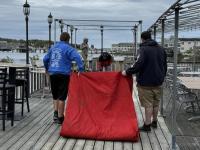The forts of Maine could use your attention
Maine is an awe-inspiring state, from the steep inclines of Mt. Katahdin, to the many lighthouses dotting the rocky coast and islands. There's much to do here for everyone, particularly hikers, fishermen, artists, and people who enjoy a good lobster. Personally, I love the forts. I enjoy the architecture and history of the large stone behemoths; they're quite intriguing. Fort Knox is, in my opinion, by far the most impressive fort still standing in the state due to the fort being well taken care of, and filled to the brim with information.
The construction of the fort began in 1844 in the wake of the Aroostook War, a fight over the northern border of the state. The "war" is a loose term for the conflict, which lasted a whole year between 1838 and 1839. The official border between the U.S. and then British Canada was settled in 1842. The Penobscot River had been attacked in 1814 by the British during the War of 1812. The American forces were outnumbered by the British who sailed up the Penobscot to loot Hampden and Bangor in the Battle of Hampden. There was worry about the vulnerable region, and so the fort was built. Construction continued until 1869, when many forts were deemed unusable due to the development of better military technology. To this day it is still incomplete, though you can't notice it. The fort was manned during the Civil War and Spanish-American War, but it was never needed.
Today, visitors can explore the fort from May 1 to Oct. 31, and residents of Maine get discounted tickets. The fort is a good place to spend a whole day, and is quite beautiful, yet also cold and menacing. When I had visited, in early October, there had been a fire going in the Officers Quarters, a good place to warm up. If you ever decide to go there, I suggest that you bring a flashlight for there are many dark passageways and uneven flooring. (This applies to many of the other forts in the state.) The fort even still has its bakery and many Howitzer cannons used during the Civil War.
Fort Popham was built on top of an old battery which saw only minor action during The War of 1812. The fort was built in 1861 at the mouth of the Kennebec River, but it remains unfinished due to the sweeping end of fort construction in 1869. It was manned during the Civil War, the Spanish-American War, and World War I. Fort Popham was no longer needed when Fort Baldwin, equipped with newer, longer range cannons was built up above it. Fort Popham was still manned during World War I because there was a minefield in the water surrounding the fort, and it had to be watched. Since it's quite small, a half-day visit is sufficient to take in some great views of the Atlantic and an example of the beautiful-yet-functional architecture of the mid-nineteenth century. You can also take a walk to a small beach and see how large and impenetrable Fort Popham is from the outside.
Fort Baldwin is a less commonly talked about fort, one you aren’t be able to see if you are just driving by. It's located in Phippsburg near the mouth of the Kennebec River. Construction of Fort Baldwin began in 1905 and ended in 1912. Unfortunately, this fort isn't kept up in the same way that some of the others around Maine are, which is quite disappointing.
The fort is made up of three buildings, all batteries that are littered along a hiking path. I enjoy exploring the dark, damp old buildings, with a flashlight, of course. There is still some metal grating on some of the windows, and you can climb atop the buildings to get a view of the ocean. The fort was manned during both World Wars. Battery Cogan has two three inch pedestal mounted guns and housed the electrical equipment which powered the fort. Battery Hardman also has one six-inch cannon. On Battery Hawley you can find two large pedestal mounts that were used to mount six-inch cannons. An observation tower was built during World War II to watch for enemy U-boats. If you visit, you can walk around the tower and peer in through a grated door, or through a window, but there is no access to the look-out. Fort Baldwin is an interesting park to visit, it's dark rooms are filled with water, so don’t forget to bring your rubber boots. There are some very well preserved and fascinating fireplaces.
Farther up the coast overlooking the Sheepscot River, Fort Edgecomb sits on Davis Island in Edgecomb. This small, octagonal fort is made of wood and is currently covered in shingles. Slots for muskets on the first floor and openings for cannons on the second let in very little light to the dark, damp fort. Construction lasted from 1808 to 1809. At the time, Wiscasset was an important trading port, and the fort was built to protect the town. The fort was manned during the War of 1812 and used as a prison for captured British soldiers and during the Civil War. Fort Edgecomb also comes with some grounds to explore. One atypical thing about the fort is all of the graffiti. Now, it's not spray paint graffiti. There are hundreds of etchings in the wood on the second floor. The carvings are all words, names, and dates. Many date back to the late nineteenth and early twentieth centuries. Others are newer, but it's still fun to go through and read the names and dates, trying to find the oldest or most interesting. It’s almost like a scavenger hunt.
These are just a few of my favorite forts in Maine, and there are many more to explore: Fort William Henry in Pemaquid, Fort McClary in Kittery, Fort Preble in Portland, and so many more! Many of these forts are still not preserved as well as Fort Knox or Fort Popham. Fort Gorges, located at the entrance of the Portland Harbor is quite dilapidated and is currently being restored so more people can enjoy the history of our state. Sometime in the future, perhaps even you, dear reader, may be able to visit one of these forts. When you do, make sure you provide a donation to enable more people to enjoy the history of the beautiful state we live in by preserving it.
Event Date
Address
United States





















